|
Papaya
Previous
Next
Up
Home
Carica papaya
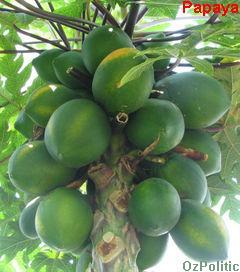
Papaya are often referred to as pawpaw in Australia, however this name is usually reserved for a tree native to the US (see lower photo). Papaya are native to tropical regions of central and south America.
Papaya are easy to grow and fruit quickly. I had some come up out of buried compost, from the seeds of a store-bought papaya, which have already produced fruit. They don't take up much room and tolerate shade, though they will produce much more fruit in full sun. They are handy for small spaces that are unsuitable for more demanding trees. They are also useful as an intermediate crop to be planted between other fruit tree seedlings until they become established.
My first attempts to plant more largely failed. I grew a number of them in one location, then transplanted them. I didn't put any effort into soil preparation. I just used a screwdriver to put a hole in hard soil just big enough to get the root system into. Most of these dried out and died. Some were damaged by turkeys. Some had all the leaves eaten off by possums and are still alive, but not doing too well. I recently planted some more and mixed garden clippings into the soil and covered them with chicken mesh to keep the possums off. Fingers crossed. The seeds come from a variety of sources - a neighbour, store bought fruit and the fruit I grew myself. I can't remember which is which and I take the philosophy that whatever grows is most suitable to the area. They are easy to grow so I use a shotgun approach - plant a lot and don't worry if some die.
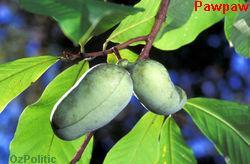
Papaya come as male or female trees. Apparently you can get them to change sex from male to female (fruiting) by driving a nail into the trunk. I tried this and nothing happened, so I tried driving in a large screwdriver. The wood is very soft. A few months later the previously male tree produced fruit, but these hung on much longer stems, whereas the fruit of the female tree were attached by a stem of about 1cm in length to the main trunk. I'll post an update when I taste these fruit.
A neighbour gave me some flyscreen mesh to cover them to keep the possums off, which worked. I haven't covered the new fruit on the other tree yet and already something has bitten them, even though they are still small and green. I suspect that possums do this to make the fruit rot and therefore ripen faster, as I have known them to bite into lots of green tomatoes without eating anything.
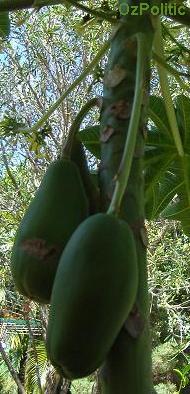 The papaya, also known as mamão, tree melon, fruta bomba, lechosa (Venezuela, Puerto Rico, the Philippines and the Dominican Republic), or pawpaw is the fruit of the tree Carica papaya, in the genus Carica.
The papaya, also known as mamão, tree melon, fruta bomba, lechosa (Venezuela, Puerto Rico, the Philippines and the Dominican Republic), or pawpaw is the fruit of the tree Carica papaya, in the genus Carica.
It is a small unbranched tree, the single stem growing to 5-10 m tall, with the spirally arranged leaves confined to the top of the trunk; the lower trunk is conspicuously scarred with the leaf scars of where older leaves and fruit were borne. The leaves are large, 50-70 cm diameter, deeply palmately lobed with 7 lobes. The flowers, similar to the flowers of the Frangipani, are produced in the axils of the leaves, maturing into the large 15-45 cm long, 10-30 cm diameter fruit. The fruit is ripe when it feels soft (like a ripe avocado or a bit softer) and its skin has attained an amber to orange hue. Papaya is also known as papoya in Japan.
Cultivation and uses
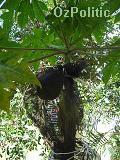 Originally from southern Mexico, Central America and northern South America, the papaya is now cultivated in most countries with a tropical climate like India, South Africa, and the Philippines.
Originally from southern Mexico, Central America and northern South America, the papaya is now cultivated in most countries with a tropical climate like India, South Africa, and the Philippines.
The primary use of the papaya is as an edible fruit. It is usually eaten raw, without the skin or seeds. The unripe green fruit of papaya can be eaten cooked usually in curries, salads and stews.
Papaya is rich in an enzyme called papain (a protease which is useful in tenderising meat) and other proteins. Its utility is in breaking down the tough meat fibres and it has been utilized for thousands of years in its native South America. It is included as a component in powdered meat tenderisers. Papaya enzyme is also marketed in tablet form to remedy digestive problems. Caution should be taken when harvesting, as papaya is known to release a latex fluid when not quite ripe, which can cause irritation and provoke allergic reaction in some people. The papaya fruit and leaves also contains carpaine, an anthelmintic alkaloid which could be dangerous in high doses.
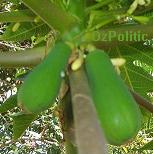 Papain is also popular (in country's where it grows) as a topical application in the treatment of cuts, rashes, stings and burns. Papain ointment is commonly made by fermented papaya flesh, and applied as a gel-like paste.
Papain is also popular (in country's where it grows) as a topical application in the treatment of cuts, rashes, stings and burns. Papain ointment is commonly made by fermented papaya flesh, and applied as a gel-like paste.
Women in Pakistan, India and Sri Lanka and other parts of the world have long used papaya as a folk remedy for contraception and abortion. Medical research in animals has confirmed the contraceptive and abortifacient capability of papaya, and also found that papaya seeds have contraceptive effects in adult male langur monkeys, possibly in adult male humans as well. Unripe papaya is especially effective, in large amounts or high doses. Papaya is not teratogenic and will not cause miscarriage in small, ripe amounts. Phytochemicals in papaya may suppress the effects of progesterone.
The black seeds are edible, and have a sharp, spicy taste. They are sometimes ground up and used as a substitute for black pepper. In some parts of Asia the young leaves of papaya are steamed and eaten like spinach.
Excessive consumption of papaya, like of carrots, can cause carotenemia, the yellowing of soles and palms which is otherwise harmless.
The papaya fruit is susceptible to the Toxotrypana curvicauda, or Papaya Fruit Fly. This wasp-like fly lays its eggs in young fruit.
|